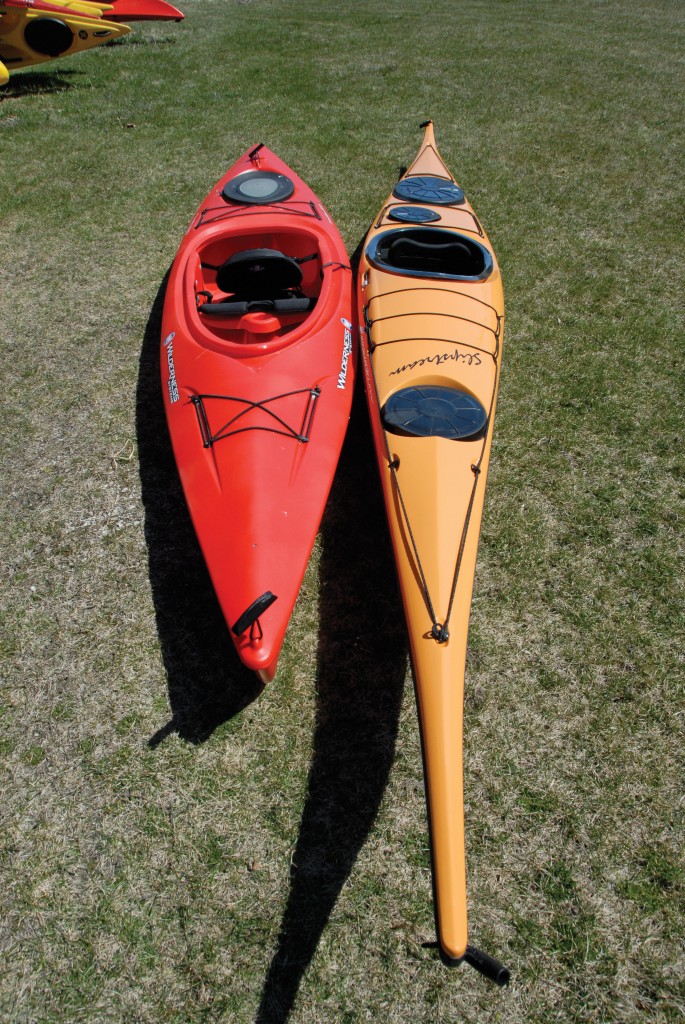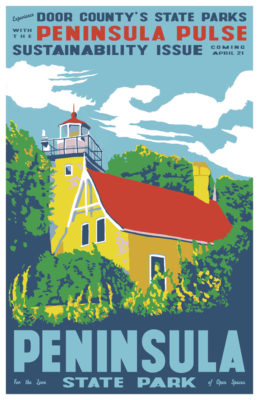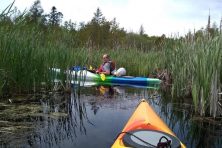Springtime Kayaking: The “Door” to early season paddling
- Share
- Tweet
- Pin
- Share
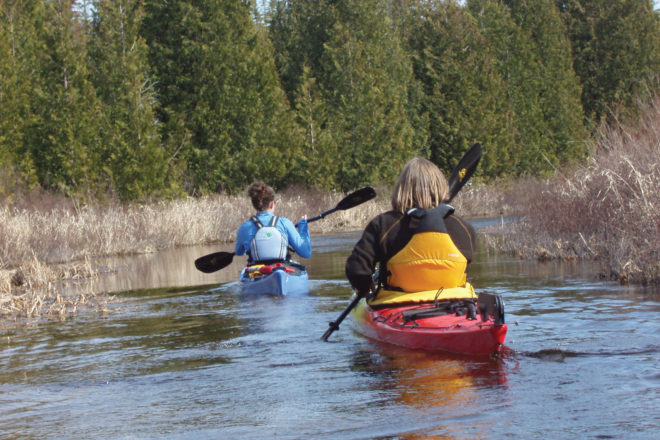
There’s a mellow May breeze rustling the reeds and wild rice along Reibolts Creek. Yellow water lilies bob gently in the wake of the boat, and the high whistle of a Blue-winged Teal breaks the stillness of the foggy dawn as the sun rises over Moonlight Bay. A morning like this one is not uncommon this early in the season, but finding tranquility and silence in the hustle and bustle of a Door County spring certainly can be. Luckily, this quiet, off-the-beaten-path spot isn’t difficult to get to. In fact, for those willing to do a bit of exploring, pristine sites around the Door Peninsula are far closer than they may seem. All that’s needed is a kayak.
In the late 1980s, when Trek ‘n Trail began renting kayaks at the Wagon Trail Resort on Rowleys Bay, the sport was just beginning to gather its strength and popularity. In just under a decade, Door County would become a Midwestern hotspot for paddling.
The Outdoor Industry Foundation’s 2006 Outdoor Recreation Participation Study found that “during 2005, the number of Americans participating in kayaking grew significantly over previous years.” The number grew by 25 percent from the previous year, to be exact, with over 12.6 million participants going on some 86 million outings. A whole new generation of paddlers is being introduced to the sport, and what’s more noteworthy is that almost a third of the participants from the study are over the age of 45. For paddlers of all ages, kayaks are a comfortable, secure, and stable way to see some of the most pristine areas that many other boaters just don’t have access to due to boat size and water depths.
Many newcomers to kayaking were introduced to canoeing first, and though kayaks and canoes have some structural similarities, a kayak has a covered deck and is powered by a double-bladed paddle while a canoe has an open deck and is powered by a single-bladed paddle. When paddling, the kayaker sits in the hole, or cockpit, of the boat, putting the paddler close to the waterline and making the boat quite stable. The cockpit of the kayak can be sealed with a spray skirt in order to keep water and waves from splashing into the paddler’s lap and filling the boat with water.
Although new to the county 20 years ago, kayaking itself is certainly not new. Kayaks were invented thousands of years ago by the Inuits. Made with wooden frames and seal skins, they were initially designed for hunting and fishing. Over the centuries, kayaks saw many shifts in material and design, and today kayaks come in all shapes and sizes to fit people of all ability levels. Paddlers interested in anything from the gentle pace of flat-water paddling to the adrenaline-pumping experience of a whitewater kayaking adventure can find a kayak to fit their needs.
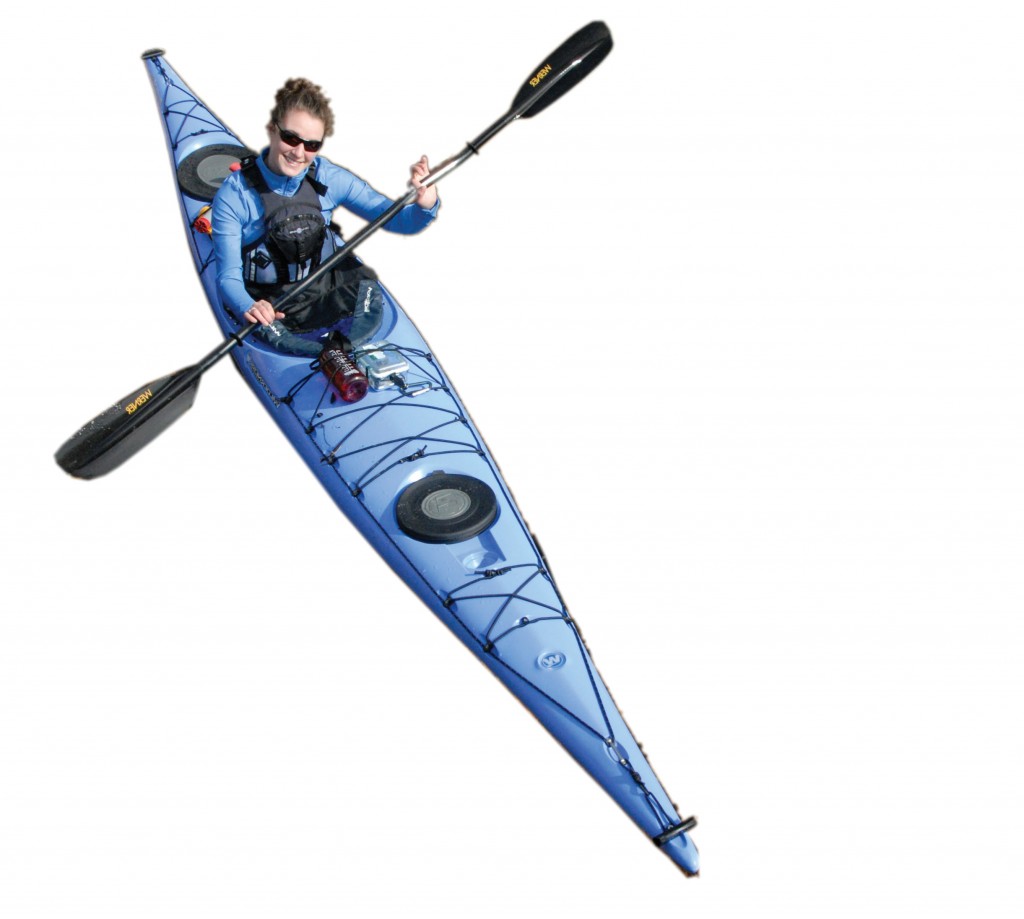
According to makers of Perception Kayaks, one of the industry’s leading manufacturers, the boats can be divided into five general categories: whitewater, recreational, sit-on-top, day touring, and long-range touring. Recreational kayaks are best suited for paddling in the springtime around Door County. Rick Wylie, owner of Bay Shore Outdoor Store in Sister Bay, suggests, “Recreational kayaks are ideal for spring paddling because they are highly maneuverable and also very stable.” In recent years, recreational kayaks have seen the greatest proliferation in versatility and design. They generally range from nine to thirteen feet and are ideal for beginners, families, and folks wishing to explore smaller inland lakes and slow-moving creeks and rivers. The cockpits of these boats are larger and wearing a spray skirt is not usually necessary. Unlike the sea kayak, recreational kayaks are short and wide. The trade-off, however, is that they aren’t as fast as longer, thinner boats. For most kayakers this is not a concern as the paddling is meant to be slower paced and laid back.
When asked why Door County is such a draw for paddlers, Wylie stated, “The geography of the county covers the entire gamut of paddling. In Door County, we have everything from streams and small lakes to freshwater estuaries, rugged shorelines, and even deep water passages.”
Door County has more than 300 miles of shoreline and more state parks than any other county in the entire country, making it extremely attractive to boaters of all kinds.
Another reason that Door County is such an exceptional place to kayak is that paddlers have access to one of the area’s most prized and valued resources: protected lands and waters. Each year, more and more land around the peninsula has come under the stewardship of such organizations as the Wisconsin Department of Natural Resources (DNR), the Nature Conservancy, the Door County Land Trust (DCLT), and the Ridges Sanctuary for permanent protection. “Door County is uniquely blessed with outstanding natural areas,” said Mike Grimm, conservation ecologist with the Nature Conservancy. One of the best ways to experience these areas is by water. “Water is a public trust and a public resource,” Grimm stated, “and paddling is a quiet way to move through a stream and across the earth.” Kayaking, then, brings together two wonderful worlds: a sport growing rapidly in popularity and access to some of the most ecologically diverse and exciting places in the county.
The open waters and beautiful coastline of Green Bay and Lake Michigan have obvious appeal to sea kayakers and recreational kayakers alike, but being out on the open water in the springtime can present adverse paddling conditions. Water temperatures still hover in the 30s and 40s and unpredictable weather conditions can turn kayaking into a challenging and even dangerous venture. Therefore, taking advantage of the high water and the slightly warmer temperatures of inland lakes and creeks on the peninsula is the safest and often most enjoyable way to kayak in the spring.
On the list of easily accessible and scenic locations for spring paddling is the Reibolts Creek and Mud Lake area. The entrance to the creek is located off Highway Q north of Baileys Harbor. Mud Lake Wildlife Area was designated a State Natural Area in 1975 and is protected by the Wisconsin DNR. The area consists of the 155-acre lake which is surrounded by a large timber swamp. Reibolts Creek runs from Mud Lake to Lake Michigan and, come mid-summer, the creek is difficult to paddle due to reeds, downed trees, and decreasing water levels, so taking advantage in the spring months is suggested. The Reibolts Creek and Mud Lake area has a truly untamed and isolated feel. Twisting and turning along the creek and breaking out into the gradual panorama of Mud Lake makes a kayaker completely forget that just a few miles away the busy tourist towns are filled with people and activity. Stepping into a kayak is often like stepping back in time.
To Terrie Cooper, Land Program Director with the Door County Land Trust, the appeal of kayaking is “the balance of land meeting water and creating so many natural indentations and so many miles of coastline that create amazing natural communities and new places to explore.” Raised in Door County, Cooper was first exposed to kayaking through Trek ‘n Trail at Wagon Trail in the early 1990s. “I instantly fell in love with kayaking,” she remembers. She went on to attend sea kayak symposia all over the Midwest and paddled in exotic locations like Baja, Honduras, and the Virgin Islands, as well as waters a bit closer to home in Lake Superior, the Apostle Islands, and Isle Royale – though her heart was always back home in the Door.
For Cooper, North Kangaroo Lake and Peil Creek is a familiar spring paddling spot. Peil Creek originates from various smaller springs located in the 40-acre basin two and a half miles above Kangaroo Lake. The Nature Conservancy and the Door County Land Trust protect 500 acres of land surrounding the North Kangaroo and Peil Creek area. The creek flows southeast through the woods before reaching the lake and is surrounded by sugar maple, white birch, ash, and oak. “
Bald Eagles, osprey, and Caspian Terns feed on the lake,” Cooper explains. “The area is also home to the federally-endangered Hine’s Emerald Dragonfly.”
A kayaker can launch from the causeway that runs across Kangaroo Lake on County E and tour the north end of the lake, enter the mouth of the creek comfortably and, if desired, climb out to take a walk around the surrounding protected lands.
For those kayakers who are interested in really getting off the beaten path, they’ll need to take a boat – a ferry, that is – to get to this next paddling spot: Washington Island. In recent years, the Door County Land Trust has increased their protected areas in this northernmost part of the county. The island is home to a vibrant year-round 700-person community and rich cultural and maritime history. Exploring the waters around the island is usually best done in summer, but there’s one spot in particular, the Richter Bayou, that revels in the beauty of spring. Actually an estuary, the Richter Bayou (called such by the islanders) was donated by Arni Richter and his family to the DCLT. The 180-acre area protected by the DCLT supports the most productive smallmouth bass nursery in northern Green Bay according to the Wisconsin DNR. The Bayou is a beautiful, winding estuary that leaves the kayaker at the mouth of Detroit Harbor and is filled with white cedar, quaking aspen, and sugar maple. “These lands are incredibly important,” Grimm states, “and we hope people appreciate and respect them.”
Exercising mindfulness, as with all outdoor activities, is essential when it comes to exploring these protected lands.
“Even something as simple as grinding your paddle into the creek bottom to shove off can be disruptive,” Wylie points out. All of these locations are home to nesting birds, aquatic plant life, and insects that use the water and surrounding areas for habitat.
“Especially when you’re in soft-bottom, slow-moving systems, even if you’re not pushing off bottom, you can still stir it up,” explains Grimm.
For example, on Kangaroo Lake, marl from the bottom is stirred up by motorboats and high amounts of activity.
“Marl substrate is precipitated calcium carbonate, like chalk, and when stirred up it stays in suspension and impedes the regeneration of plant life, which in turn, affects the whole ecosystem of the lake,” Grimm states. This notion is highly evident south of the causeway where a person can see approximately twelve inches down from the surface, but on the north side three feet is visible due to less marl disturbance.
Cooper probably said it best when she simply stated, “Tread lightly, visit quietly. Don’t travel in large groups and stay on the trails, land and water alike.”
It is also important to be mindful of invasive species and practice techniques like scrubbing the hulls of boats and wiping feet between trips so as not to spread any non-native species. After all, the central concept to preserving land and water is to protect those plant and animal species that make Door County so beautiful, so diverse, and so very unique. For a kayaker, being mindful and aware of surroundings will also help them to prepare for a safe trip.

Kayaking Door County in the spring is very beginner friendly because people don’t need to be pros, they just need to be prepared and smart.
“It is best to dress in synthetic, quick-dry layers of clothing to maintain comfort,” Wylie suggests. Experience is talking as he explains appropriate clothing and equipment for kayaking. Wylie is a long-time paddler himself, and his knowledge and experience make him one of the county’s most excellent resources on the sport. “Also, choosing waterproof or neoprene socks and gloves will help to keep kayakers comfortable,” he explains.
Kayakers always need to exercise caution when heading out and should dress as if they are going to be getting wet. Even in shallow water, getting wet can be detrimental to safety. Paddlers should always leave a float plan behind with a schedule either in their vehicle or with another person. To ensure the happiest, driest adventure, all kayakers should carry along a cell phone, a safety whistle, a waterproof light, and a sponge to keep out excess water. Even better, going along with a paddling buddy or a kayak tour service is the best way to experience a new sport and a new location.
It is difficult to put words around what draws people to certain places and activities. For many in Door County, it’s the draw of the unique, the natural, and the wild. It is the notion that in some places in our country, you can still step off the back porch into adventure. The naturalist John Muir often spoke of “throwing a loaf of bread and a pound of tea in an old sack and jumping over the back fence.” Here in Door County, there are miles and miles of “fence.” Standing in the middle of one of our busy towns, it’s easy to forget that there are tangled backwoods and twisting, untamed creeks just off the highway. With buildings and roads slowly creeping onto the landscape, sometimes it’s even easier to forget. But for some, the water is where it’s at – as is the case for Terrie Cooper, who reminds herself that “the bays, the streams, the channels between the islands, the water…that’s the true wilderness of Door County.”
Kayak Types
Whitewater Kayak
Length: 8-9 feet
Design: Small cockpit, tight fit
Types of water: Fast moving rivers, whitewater rapids
Composition: Roto-molded plastic
Sit-on-Top Kayak
Length: 8-17 feet (single or tandem)
Design: Open hull concept, sat upon instead of inside
Types of water: Slow moving, flat water. Best in warm water and tropical climates
Composition: Roto-molded plastic
Recreational Kayak
Length: 9-13 feet (longer for tandem)
Design: Wide, flatter hull. Large cockpit for comfort and ease
Types of water: Flat water, coastlines, inland lakes. Not designed for long trips.
Composition: Roto-molded plastic, hybrid plastic
Day (or Light) Touring Kayak
Length: 14-16 feet
Design: Medium cockpit, entry level sea kayak
Types of water: Flat, open water, coastlines, and inland lakes. Capable of going out in less-than-ideal conditions.
Composition: Roto-molded plastic, hybrid plastic, fiberglass, Kevlar
Long Range Touring (Sea Kayaks)
Length: 15-17 feet (longer for tandem)
Design: Smaller cockpit, thin beam, rounded hull, often will have a rudder or skeg for turning and tracking.
Types of water: Oceans, lakes, deep-water passages
Composition: Roto-molded plastic, hybrid plastic, fiberglass, Kevlar, wood, skin
Door County Kayak Sales, Rentals, and Tours
Bay Shore Outdoor Store
655 S. Bayshore Drive
Sister Bay, WI 54234
(920) 854-7598
www.kayakdoorcounty.com
Sales, Rentals, & Tours
Kayak Tours, LLC
3655 Peninsula Players Rd. (Hands On Art Studio)
(920) 854-9292
www.doorcountykayaktours.com
Rentals & Tours
Door County Living Classrooms
5880 Cedar Creek Place
Sturgeon Bay, WI 54235
(920) 746-0056
www.doorcountylivingclassrooms.com
Door County Kayak Tours
Team Leadership Center
4497 Ploor Road
Sturgeon Bay, WI 54235
(920) 746-9999
www.teamleadership.com
Ephraim Sailing Center
South Shore Pier
(920) 854-4336
www.kayakdoorcounty.com
Rentals & Tours
Nicolet Beach Concessions
Peninsula State Park-Nicolet Beach
(920) 854-9220
www.kayakdoorcounty.com
Rentals
Wagon Trail Marina
1041 County Road ZZ
Ellison Bay, WI 54210
(888) 250-7666
www.wagontrail.com

